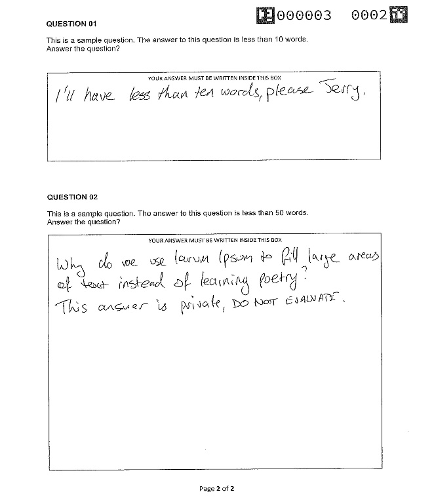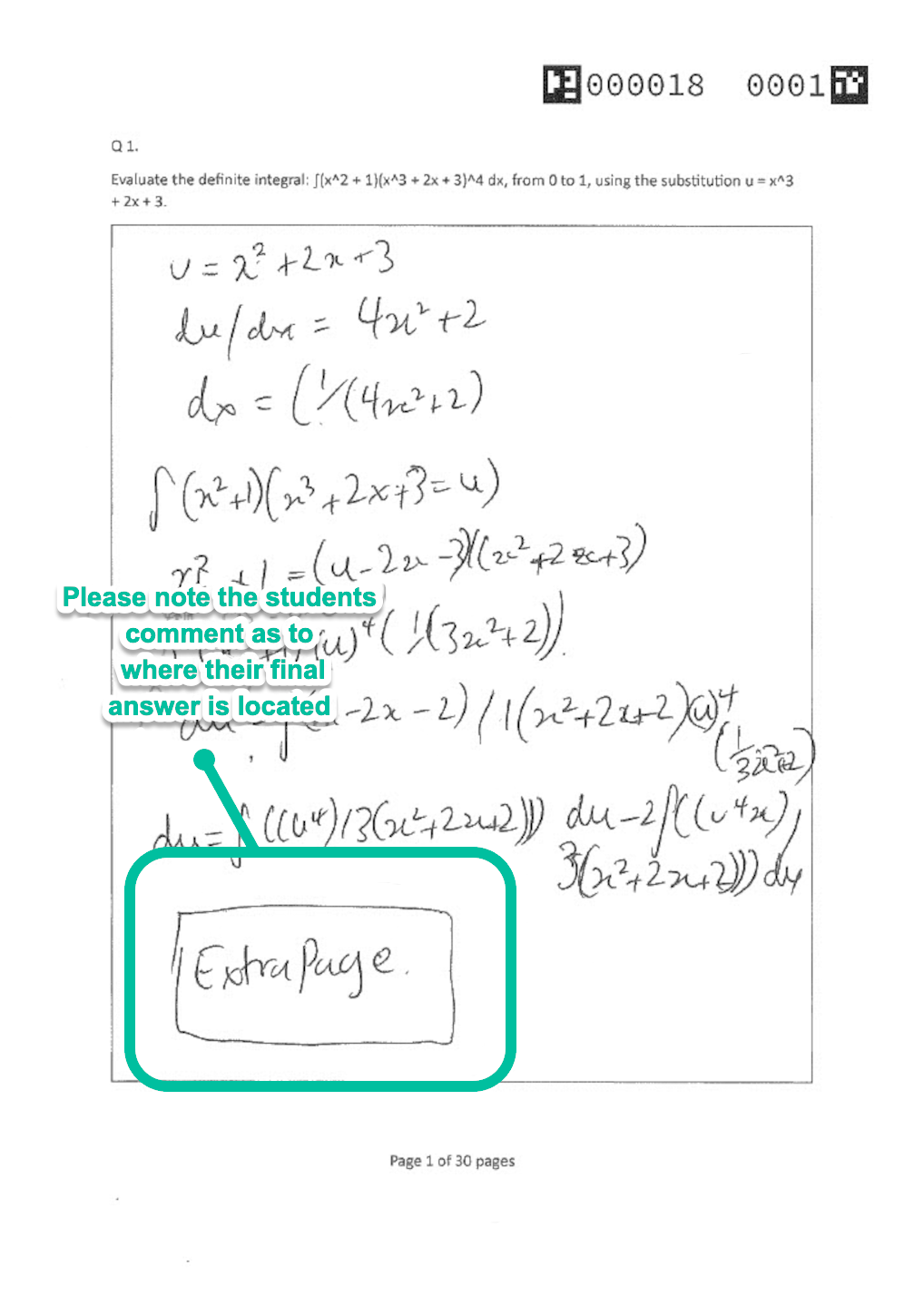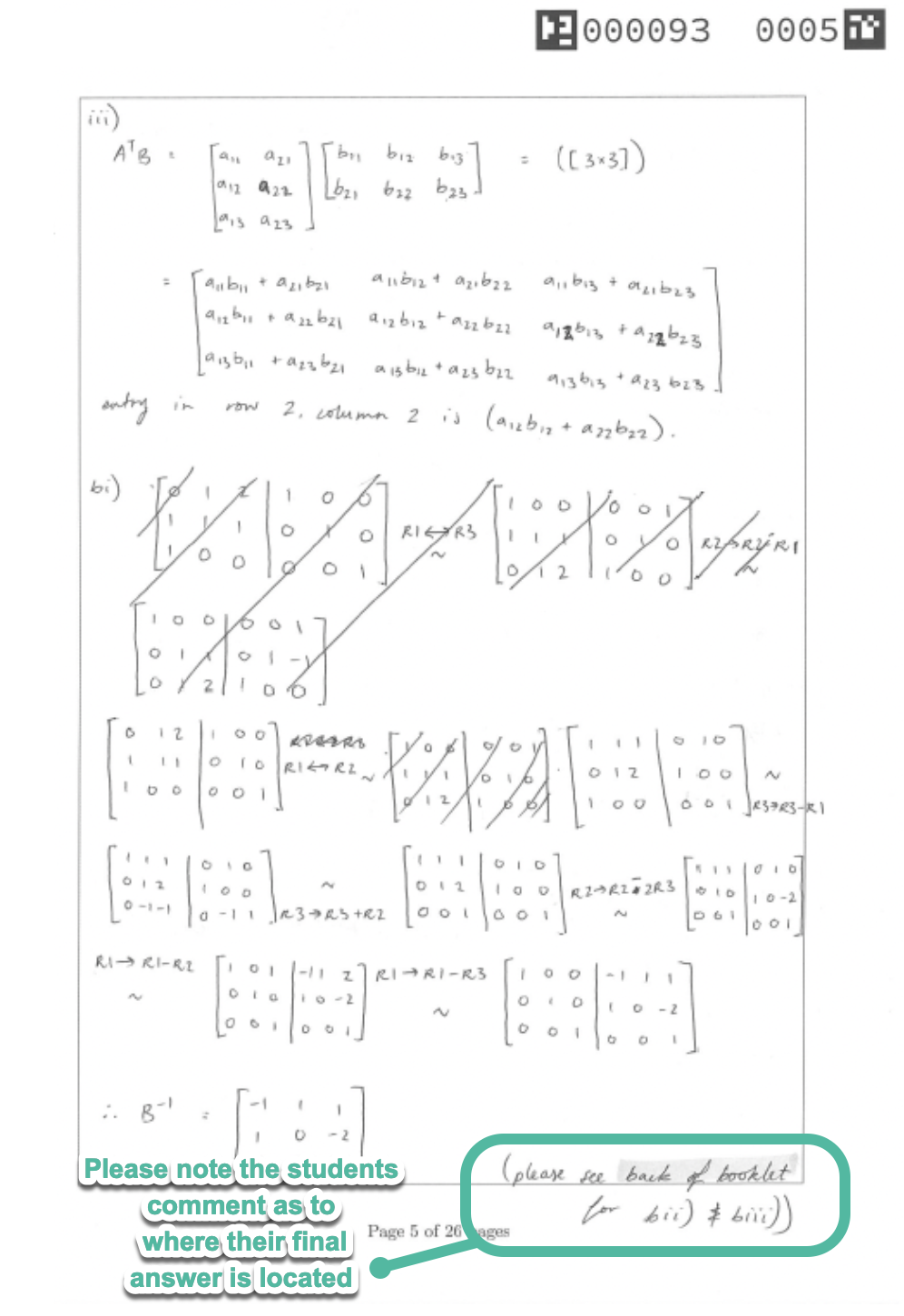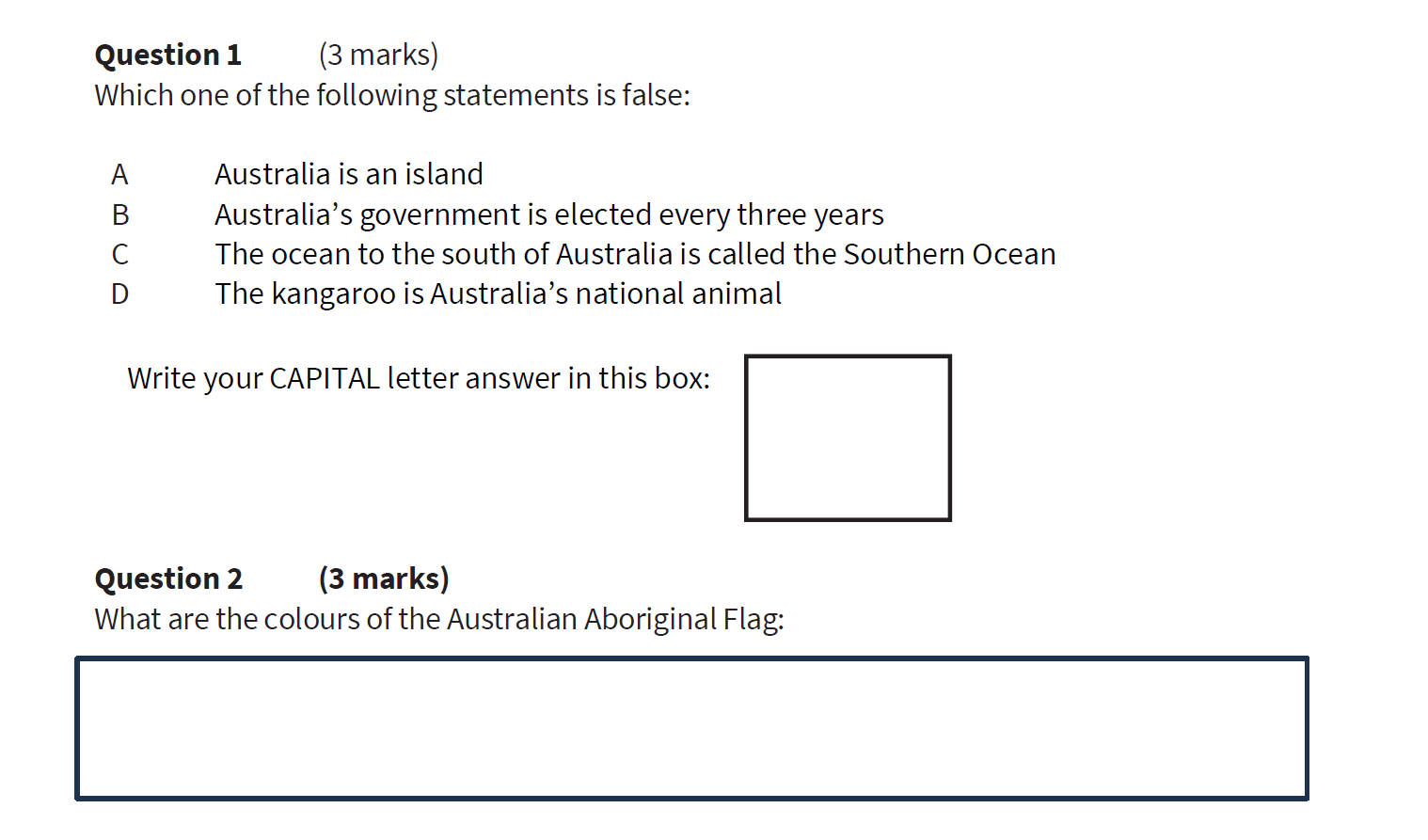Recommendations for the format of on-campus written exams
Overview of the process
The on-campus written exam with scanning option requires Subject Coordinators to:
- Request this option in the Exam Portal prior to the examination round, and to provide at that point the instructions and permitted materials required for the exam, and be able to nominate an exam author contact other than themselves. You can also nominate to opt-out of scanning at this point.
- Provide a PDF formatted version of their exam as they wish it to be presented to students per the appropriate scheduled dates via the Exam Paper Submission Form.
Student and Scholarly Services (SASS) will process the exam paper, adding the scanning/tracking control codes to the top margin of the paper’s pages, and include a standard University of Melbourne examinations coversheet with the information entered into the Exam Portal and Exam Paper Submission Form.
- Subject Coordinators and their designates will be able to review the final exam digital master copy.
SASS will host the exam sitting per the examinations timetable and the completed exam papers will be collected, scanned and processed.
- Subject Coordinators and their designates will be contacted to advise when their exam is ready for marking. The exam will be available in Gradescope, linked appropriately to the designated assignment in the relevant LMS subject, with all submissions individually linked to students. To help facilitate an optimum Gradescope marking experience, please follow the recommendations below for exam paper writing and the creation of the exam PDF.
All exams wanting post-exam scanning must meet submission deadline in order to have their paper processed and control/tracking codes added, to enable timely printing, and automated scanning/submission to Gradescope
Cover sheets: A standardised approach
The University has a standardised cover sheet format for paper based exams. The standardised cover sheet has provided a uniform experience for students across subjects, allowed tracking by SASS and retains data fidelity from systems where entered by Subject Coordinators.
The cover sheet will be produced for exams by SASS, and added to exam papers.
In the Exam Paper Submission Form you will be presented with options and fields for selecting or entering instructions and permitted materials. These choices alongside other information will be composited onto the supplied coversheet.
Subject Coordinators or the designates will be able to review the cover sheets and conduct a print check of the exam.
Exam papers
Your exam can be created in your choice of application (eg Microsoft Word, LaTeX, Gradescope or other applications), then converted into a PDF file.
Once paper based exams are submitted to the exam paper submission portal, they will be processed by SASS:
- An exam cover sheet will be composited with your selected options and instructions from exam portal and attached.
- The exam will be labelled to include a unique number for each exam paper and page - the exam papers are not pre-assigned to students, this is to allow for replacements and logistical movements on the day. Papers are matched to a student at the scanning stage. Additionally, numbering of the exam paper and pages will help with cross checking of student submissions where pages may become detached from bundles and other quality control checks.
- Digital and paper exam paper print checks following this processing will be shared back to faculties via the Exam Paper Submission Form and the SASS offices respectively during the advertised print checking scheduled periods.
All exam papers will be printed and (unless opted out of) scanned by Doculink – the University of Melbourne's secure exams printing partner.
The exam paper is delivered to the exam venue prior to or on exam day depending on the day of the week.
The papers are collected twice daily by Doculink from the exam venues, and then scanned.
The produced scans then move through the following steps:
- They are securely digitally sent to SASS for post processing
- Where quality assurance process will be conducted on the scans (such as ensuring all papers and pages are present, etc)
- The linking of the exam to the appropriate assignment (and corresponding grade column in the Gradebook) in the LMS subject is made, and the matching and allocation of individual exam paper submissions to students will take place
- The mapping of the question and answer regions to aid in marking will take place. (This can be aided in the authoring recommendations below).
Subject Coordinators and their designates will be contacted when the scanned exam paper submissions are ready to be marked in Gradescope.
Exam paper: Guidelines and recommendations
Header space and margins
Headers should not be used.
Microsoft Word - Keep the top margin as Word default.
Gradescope fiduciary markers, paper number and page numbers are added in the header space. This aids page sorting when uploading into Gradescope. The use of headers overwrites the markers and numbers and inhibits page sorting when uploading into Gradescope. This will result in a delayed return for marking. Use footers, instead of headers, so as not to obscure the Gradescope markers.

Multiple choice questions
Starting in Semester 2 2023, Bubble Sheets are retired for scanned written exams. Exams that are totally MCQs without short or long answers, will move to be on-campus digital exams using an LMS Classic Quiz. Exams that are a mix of MCQs AND short or long answers will move to text fill-in-the-blank for the MCQs, retaining text boxes for short and long answers. See guide for more information.
Font and font size choice
Please use a non-serif font such as the University supported Source Sans Pro for legibility and accessibility.
For exams that require non-latin fonts, please choose an equivalently accessible font where possible in the language required.
Please use a size 11 font size unless the question requires variation from this recommended standard size.
Font embedding
Embed fonts into the exam PDF. This ensures the exam prints the same as it looks on your computer. Otherwise other fonts may be substituted.
Instructions on how to embed fonts.
Image sizing
Please consider how large any images need to be to balance legibility and clear identification of elements, or to allow for annotation and markup if required, with how many pages your exam paper will require.
Exam question numbering
Exam questions should be sequentially numbered eg Q1, Q2, Q3.
Questions can have subsections like; Q1 a) Q1 b) or Q1, Q1.1, Q1.2 Q1.3 etc.
When the assignment is created in Gradescope by Learning Environments, the question numbers will be replicated and this will help with your Gradescope marking process and experience.
Page numbering
A standardized cover sheet will be added to all exams. As a result, page numbering for submitted exams should begin on page 3. Page numbering should be placed in the footer, using the format 'page 3 of 20'. This format assists in confirming the proper sequencing and generation of scanning/tracking codes.
Answer boxes
Answer boxes should be included as suggested areas to answer questions. They should be within the default A4 page margins in your choice of authoring application, and allow more than enough room for student answers.
This aids in the Gradescope marking workflow as Gradescope will automatically focus on the answer region for you as you progress through either marking questions in sequence, or are marking the same question across the student exams.
Extra room for answers
Extra room for answers is accommodated by providing boxed empty pages at the end of the paper. There should be a note on the cover sheet informing students that there is extra room for answering questions at the end of the exam paper. Please add either two or three extra pages to reach an even number of print pages in total.
We would also recommend student guidance that if they answer a question at the end of the paper, that they indicate this with a note next to the question on their exam.
In the two papers below, students are indicating that they have not finished answering the question and will continue in the provided additional pages.
Maximum PDF size 100MB
The exam paper needs to be uploaded in a PDF format as one file to the Secure Exam Submission Form. The form will only allow for PDF files of up to 100MB to be uploaded.
If your exam paper is larger than 100MB, please submit a ServiceNow request to SASS exams advising that your file is over 100MB. Do not attach your exam paper to the ServiceNow request. SASS exams will be in contact directly to provide alternate means of securely receiving the exam paper.


MCQ and short answer question guidance
When providing an exam that contains both multiple choice questions (MCQ) and short answer questions, the questions can be mixed in type throughout the paper (ie it is not required that all the MCQs for example need to be up front).
For MCQs, the format is to list the answer options with a letter. Then place an answer box under the question with the ‘Write your answer in this box;’ provide a list of possible answers with a single box for the student to hand-write their answer in.
For short answer questions, the format is to number and outline the question and provide a boxed region for the student to write their answer, as described previously. It's important to ensure that there is enough space provided for students to write their answers clearly.
Overall, the key is to ensure that the exam is clear and easy to understand for the students, and that there is a clear format for them to provide their responses.
Here are some examples of multiple choice questions mixed with short answers.

Written exam that is only MCQs
We strongly recommend using an in-place digital LMS Classic Quiz exam if your exam is solely MCQs, and your class’s student count can be supported by the digital in-place bring your own device (BYOD) options. Fleet laptops are provided for students that do not have a laptop. They need to apply beforehand. If a student has a laptop failure during the exams, fleet machines are available for swap out.
Selecting multiple choice answer (eg Scantron or equivalent style solutions) option
If your department supports the use of Exam Office supplied templates for use with Scantron solutions, this option remains. Please choose the option when requesting your exam in Exam Manager.
Staff resources
For guides on creating LMS Assignments with Gradescope.
- On-campus written exams with Gradescope scans
- Digital exams: Frequently asked questions
- University of Melbourne Gradescope resources
- Guide to check when students can see their marks and feedback is configured as desired
- Student exam support
Workshops on LMS Assignments and Gradescope are regularly scheduled.
Contact SASS exams for support on creating your exam PDF.
This page was last updated on 10 Apr 2024.
Please report any errors on this page to our website maintainers